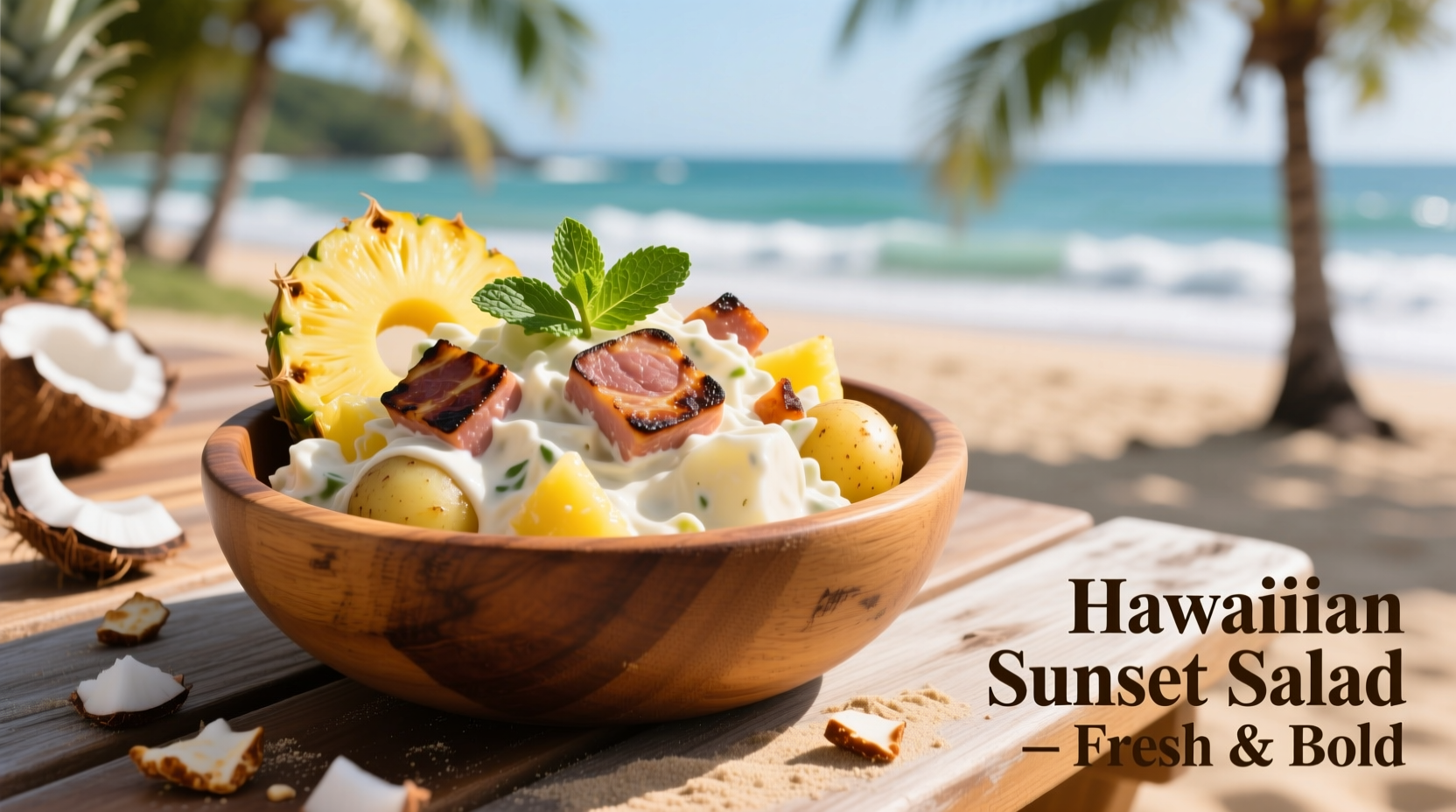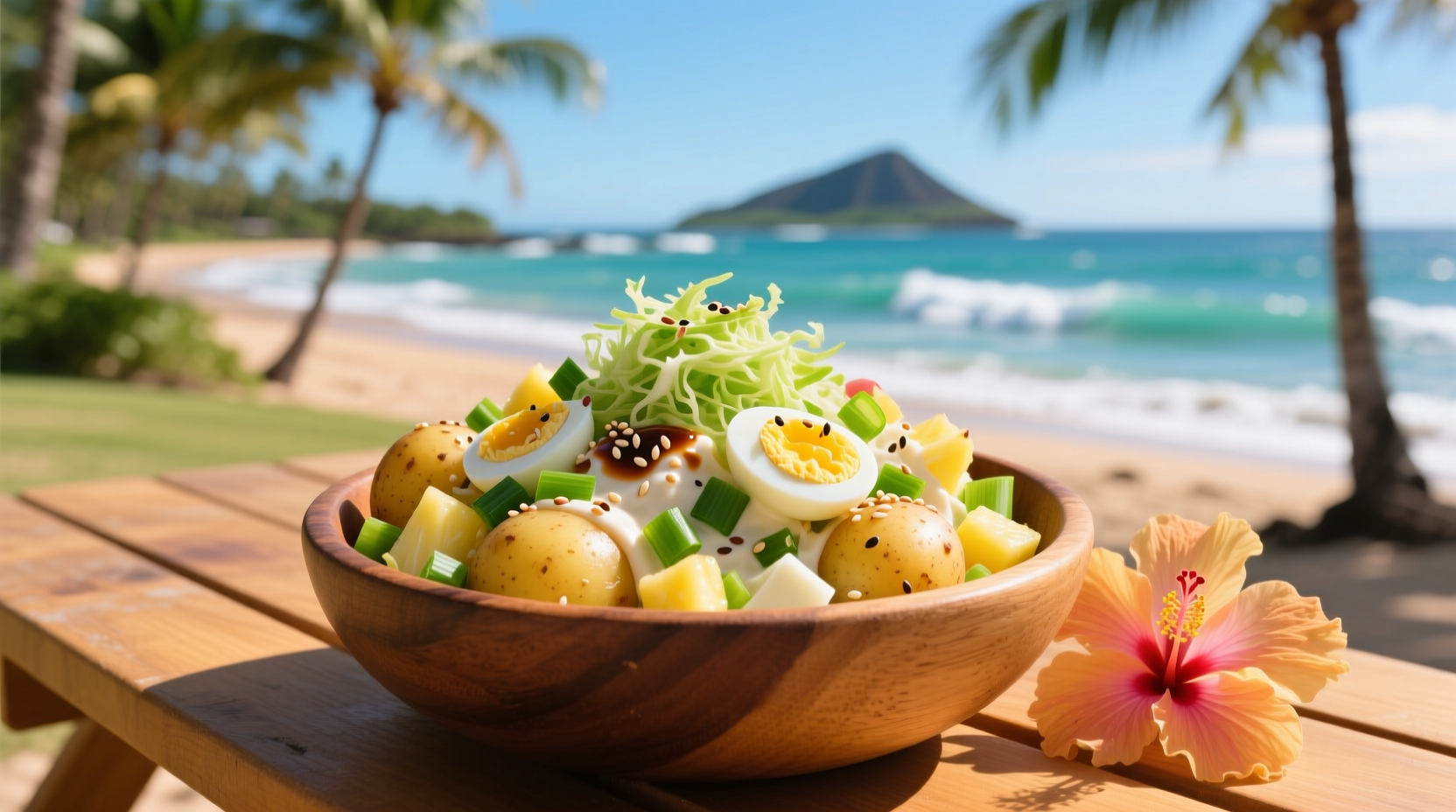What Truly Defines Hawaiian Potato Salad
While mainland potato salads focus on vinegar tang and hard-boiled eggs, Hawaiian potato salad tells a story of cultural adaptation. Born from American picnic traditions but transformed through local ingredients and tastes, this dish became a fixture at luaus, plate lunches, and family gatherings across the islands. The key differentiators aren't just ingredients—they represent Hawaii's culinary evolution.
| Traditional Potato Salad | Hawaiian Potato Salad |
|---|---|
| Vinegar or mustard-based dressing | Mayonnaise-heavy dressing with sweet elements |
| Hard-boiled eggs as primary protein | Often includes Spam, ham, or imitation crab |
| Onion predominant | Green onions with sweet relish or pineapple |
| Served cold as side dish | Served at room temperature as meal centerpiece |
| Simple herb seasoning | Shoyu (soy sauce) and sometimes ginger notes |
Your Authentic Hawaiian Potato Salad Recipe
Creating authentic Hawaiian potato salad requires understanding the balance between creaminess, sweetness, and savory elements. Based on culinary traditions documented by the University of Hawaii's Center for Pacific Islands Studies, the following recipe captures the essence of this island favorite while providing practical adjustments for home cooks.

Essential Ingredients and Why They Matter
The magic of Hawaiian potato salad lies in its ingredient synergy. Unlike mainland versions that prioritize vinegar tang, Hawaiian iterations embrace sweetness balanced with umami—reflecting the islands' diverse culinary influences.
Potatoes: The Foundation
Yukon Gold potatoes provide the ideal balance of creaminess and structure. According to agricultural research from the University of Hawaii at Mānoa, these potatoes hold their shape better when mixed with dressing compared to Russets, which can become too fluffy. Always cook potatoes until just tender—overcooking leads to mushy salad. Cool completely before mixing to prevent dressing breakdown.
Dressing: The Flavor Bridge
The dressing combines American mayonnaise tradition with Asian-inspired seasonings. Authentic versions use:
- High-quality mayonnaise (not salad dressing)
- Sweet pickle relish or finely diced pineapple
- Green onions instead of pungent yellow onions
- Shoyu (Japanese soy sauce) for umami depth
- Occasional hint of grated ginger
Protein: The Cultural Signature
Spam's inclusion isn't just practical—it's historical. During World War II, Spam became widely available in Hawaii while fresh meat was scarce. The University of Hawaii's historical food studies show how this American product was embraced and incorporated into local cuisine. For authentic flavor, dice Spam finely and pan-fry until edges crisp before adding to the salad.
Step-by-Step Preparation Guide
Follow these professional techniques to achieve perfect texture and flavor balance every time.
Proper Potato Preparation
Cook potatoes in salted water with a splash of vinegar to help maintain shape. Cut into 3/4-inch cubes before cooking for even texture. Drain well and spread on a baking sheet to cool completely—warm potatoes absorb too much dressing, creating a soggy result. This technique, recommended by culinary experts at Kapiolani Community College's Culinary Arts Program, ensures ideal texture.
Dressing Technique
Mix dressing ingredients thoroughly before combining with potatoes. The key to creamy texture without heaviness is proper emulsification. Whisk mayonnaise with shoyu and relish until fully incorporated, then gently fold into cooled potatoes. Overmixing breaks down potato structure—stop when ingredients are just combined.
Resting Period
Unlike traditional potato salad, Hawaiian versions benefit from minimal chilling time. The University of Hawaii Cooperative Extension recommends allowing the salad to rest at room temperature for 1-2 hours before serving. This lets flavors meld while maintaining the ideal slightly firm texture Hawaiians prefer. Refrigeration makes the mayonnaise stiffen too much, altering the authentic mouthfeel.
Cultural Context and Serving Traditions
Hawaiian potato salad isn't just food—it's social glue. At luaus and family gatherings, it represents the islands' "local food" culture where diverse influences blend harmoniously. Understanding when and how to serve it properly shows respect for these traditions.
When Hawaiian Potato Salad Fits Perfectly
This dish shines at casual gatherings where multiple dishes are shared family-style. It's standard at:
- Potluck-style luaus and backyard parties
- Plate lunch establishments (served with rice and protein)
- Community events and church gatherings
It's less appropriate for formal occasions or when serving delicate seafood dishes, as its robust flavors can overwhelm more subtle presentations.
Avoiding Cultural Missteps
While Hawaiian potato salad has gained popularity globally, certain adaptations miss the mark. Authentic versions don't include:
- Curry powder (more common in Japanese potato salad)
- Heavy vinegar components
- Raw garlic or strong mustard notes
- Celery (common in mainland versions)
These additions reflect other culinary traditions but stray from what locals recognize as authentic Hawaiian-style potato salad.
Troubleshooting Common Problems
Even experienced cooks encounter issues with this deceptively simple dish. Here's how to fix them:
Too Watery
Causes: Potatoes not cooled properly, excess liquid from relish, or overmixing. Solution: Drain relish thoroughly, ensure potatoes are completely cooled, and mix gently. If already watery, add a tablespoon of instant mashed potato flakes to absorb excess moisture without altering flavor.
Dry or Crumbly Texture
Causes: Insufficient dressing, overchilling, or wrong potato variety. Solution: Bring to room temperature before serving and add small amounts of additional dressing. Yukon Golds provide better moisture retention than Russets.
Flavor Imbalance
Too sweet? Add a splash of rice vinegar. Too bland? Increase shoyu incrementally. Remember authentic Hawaiian potato salad balances sweet and savory—not leaning heavily toward either.
Storage and Make-Ahead Tips
Hawaiian potato salad tastes best fresh but can be made 24 hours ahead. Store in an airtight container with plastic wrap pressed directly on the surface to prevent discoloration. Never freeze, as the mayonnaise will separate. Leftovers keep for 3-4 days refrigerated, though texture gradually changes as potatoes absorb dressing.











 浙公网安备
33010002000092号
浙公网安备
33010002000092号 浙B2-20120091-4
浙B2-20120091-4